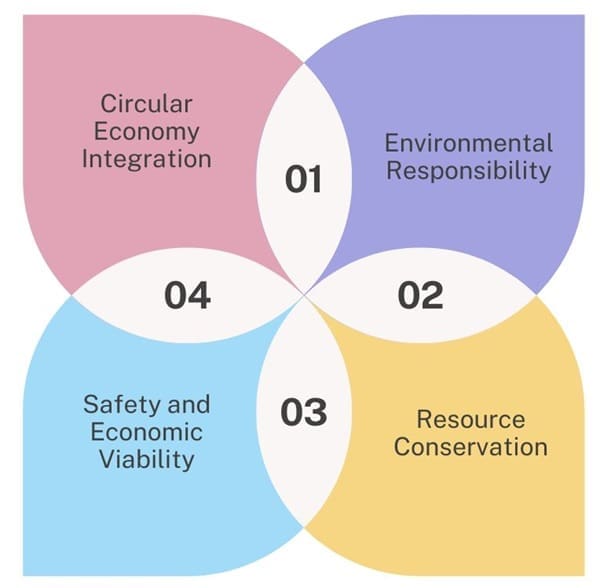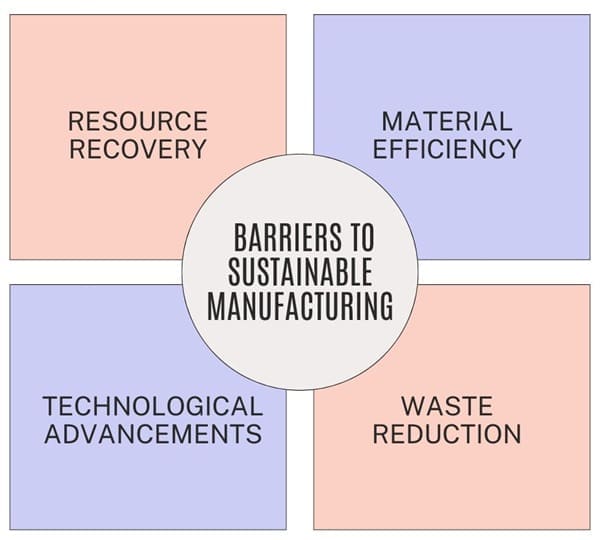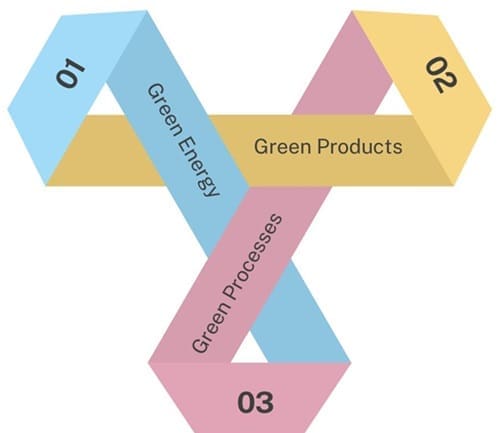Sustainable manufacturing is an effective strategy aimed at shifting production methods away from producing products with significant environmental impacts, conserving resources, ensuring safety and remaining economic viable.
Sustainable manufacturing is central to meeting present needs without jeopardizing future generations’ ability to meet their own. This comprehensive overview delves into key principles, challenges and future prospects of sustainable manufacturing.
Table of contents
What is Sustainable Manufacturing?
Sustainable manufacturing refers to any process that produces products in ways that:
- Minimize negative environmental impacts
- Conserve energy and natural resources
- Provide safeguards for employees, communities and consumers
- Are economically sound
According to the Department of Commerce, sustainable manufacturing requires taking an integrative approach that considers all stages from product conception and creation through disposal; resource efficiency must also be prioritized over minimizing environmental harm throughout.
Public, Onsite, Virtual, and Online Six Sigma Certification Training!
- We are accredited by the IASSC.
- Live Public Training at 52 Sites.
- Live Virtual Training.
- Onsite Training (at your organization).
- Interactive Online (self-paced) training,
Key Principles of Sustainable Manufacturing

- Environmental Responsibility: Sustainable manufacturing works towards reducing pollution and greenhouse gas emissions through adopting cleaner production techniques that minimize carbon footprint and other associated pollution in manufacturing processes.
- Resource Conservation: Conserving resources such as materials, energy, water and land efficiently is of utmost importance. This principle encourages waste reduction as well as reuse and recycling to extend their useful lifecycle within the economy.
- Safety and Economic Viability: Processes must ensure the well-being of all parties involved – workers, local communities and consumers. Furthermore, sustainable manufacturing must be economically viable to support long-term business success and resilience.
- Circular Economy Integration: Sustainable manufacturing is closely connected with the circular economy concept, which involves using resources for as long as possible before recycling, reusing, or repairing products so as to minimize needing new raw materials and waste generation.
The Life Cycle Approach
A critical aspect of sustainable manufacturing is adopting a life cycle approach. This involves considering all stages of a product’s life, including:
- Raw material extraction
- Material processing
- Component Manufacturing
- Assembly
- Distribution
- Use
- End-of-life disposal
Life cycle assessment (LCA) is a tool used to evaluate the environmental impacts of a product throughout its life cycle. It helps identify areas where improvements can be made to enhance sustainability.
Also Read: Sustainable Product Design
Barriers to Sustainable Manufacturing

Although implementing sustainable manufacturing practices offers obvious advantages, the task can present numerous obstacles:
Material Efficiency
Extracting raw materials has significant economic and environmental costs associated with its extraction, and sustainable manufacturing aims to minimize them by optimizing material efficiency and keeping materials within the economy for as long as possible.
However, complete circularity–meaning no new materials need to be introduced or waste produced–is a daunting goal that often proves too challenging.
Waste Reduction
Reaching zero waste can be challenging in practice; while steel and aluminium can often be recycled multiple times, other materials, like plastics and certain biotic materials pose greater challenges due to contamination and degradation over time.
Technological Advancements
Innovations in technology play an essential role in streamlining recycling processes and developing easier-to-recycle materials, like battery recycling technologies that create closed-loop systems using materials from old batteries to produce new batteries thereby dramatically reducing waste.
Resource Recovery
Recovering valuable materials from waste streams may sometimes be more cost- and energy-inefficient than extracting new raw materials, yet as high-grade ore becomes scarcer, its extraction costs increase, making waste recovery increasingly attractive. But quality and energy requirements make resource recovery an ongoing challenge.
Future Prospects of Sustainable Manufacturing

Sustainable manufacturing’s future lies in continuous innovation and adaptation in response to rising global population and urbanization trends. Here are key areas to monitor:
- Resource Efficiency: With global demand for resources increasing, manufacturers must focus on increasing resource efficiency by developing technologies and processes that use less material, energy, water and waste generation.
- Transition to Renewable Energy Sources: It is crucial that manufacturing companies transition towards cleaner sources of power such as solar, wind or other forms of renewable energy to lower their environmental impact. Shifting away from fossil-based energies like coal has shown tremendous promise when it comes to mitigating greenhouse gas emissions associated with production processes.
- Create Products for Sustainability: For future products to be effective in terms of sustainability, designers will need to keep all aspects of their life cycle in mind when creating them – this includes selecting recyclable materials as well as long-life products with easy disassembly/repair features.
- Policy and Regulation: Government policies and regulations can play a pivotal role in supporting sustainable manufacturing practices. Incentivizing adopting cleaner technologies, tighter environmental regulations, and providing resources for research and development all help push significant improvements forward in this regard.
- Consumer Awareness and Demand: Rising consumer consciousness about environmental issues has led to greater consumer interest in sustainable products, creating demand. Manufacturers that can demonstrate their dedication to sustainability may gain an edge in the marketplace.
Also See: Six Sigma Project Selection
Meaning of Green Manufacturing
Green manufacturing refers to the production of goods through processes that reduce environmental impacts. This encompasses a broad array of practices and technologies intended to reduce waste, conserve energy and resources, lower emissions of harmful substances, as well as incorporate sustainability principles into production practices for an eco-friendly production approach.
Understanding ‘Green’ and Its Importance The term ‘green’ stands for ecological sustainability and encompasses various concerns, such as air, water, and land pollution; energy usage/efficiency issues; waste production/recycling efforts and recycling programs.
Green initiatives aim to minimize human activities’ environmental impact as much as possible to create a healthier planet.
Transition to Green Manufacturing

Manufacturing companies can address environmental concerns by focusing on three key areas.
- Green Energy: Producing and using cleaner energy requires using renewable sources like wind, solar and biomass – or increasing energy efficiency within industrial operations – as the first steps toward going green.
- Green Products: Producing greener products is the next step. Consumers increasingly associate terms like recycled, low carbon footprint, organic, and natural with ‘green products. While developing these may incur higher costs initially, consumers want them, helping offset any development expenses through increased sales or premium pricing. Effective marketing may help companies recoup those expenses through increased sales or premium pricing.
- Green Processes in Operations: Implementing green practices into business operations means using resources more efficiently, cutting waste through lean operations, lowering carbon footprint and conserving water use – practices that not only increase operational efficiency but also lower costs.
Also Read: What is Smart Manufacturing?
Drivers of Green Manufacturing

Many companies have started integrating green initiatives into their operations due to several driving factors:
- Rising Energy and Input Costs: As energy and material costs increase, companies are motivated to find more efficient and sustainable ways to operate.
- Consumer Demand: Growing consumer interest in green products pushes companies to adopt more sustainable practices to meet market demand.
- Regulatory Pressure: Governments are introducing stricter environmental and waste management laws, compelling companies to comply with new standards.
- Technological Advances: Innovations provide new opportunities for businesses to adopt greener practices.
- Competitive Advantage: Companies that adopt green initiatives can differentiate themselves in the market, potentially gaining brand premium, new customer segments, and other competitive benefits.
Business Benefits of Going Green
Businesses now view green initiatives not just as a necessary expense but as good business practice. Companies that invest in green strategies can enhance their brand image, comply with regulatory requirements, attract and retain talent, increase customer loyalty, and potentially save costs in the long term.
However, realizing these benefits requires a long-term commitment and a willingness to make trade-offs against short-term goals, as the economics of green manufacturing are still evolving.
Final Words
Sustainable manufacturing is not just an environmental imperative but also an economic and social one. By minimizing environmental impacts, conserving resources, ensuring safety, and maintaining economic viability, sustainable manufacturing can help build a resilient and sustainable future.
The journey towards fully sustainable manufacturing involves overcoming significant challenges, but with continuous innovation, supportive policies, and changing consumer attitudes, it is an achievable goal.
Embracing sustainable manufacturing practices today is essential for meeting the needs of current and future generations, ensuring a harmonious coexistence between human activities and the natural environment.

About Six Sigma Development Solutions, Inc.
Six Sigma Development Solutions, Inc. offers onsite, public, and virtual Lean Six Sigma certification training. We are an Accredited Training Organization by the IASSC (International Association of Six Sigma Certification). We offer Lean Six Sigma Green Belt, Black Belt, and Yellow Belt, as well as LEAN certifications.
Book a Call and Let us know how we can help meet your training needs.




















